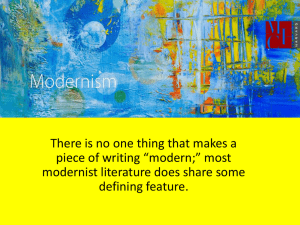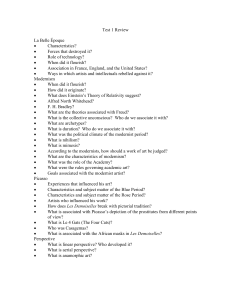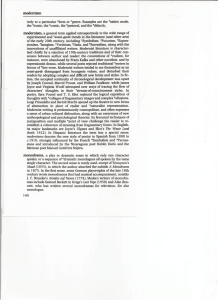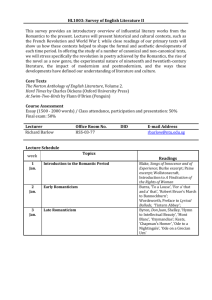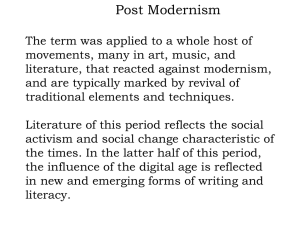Word Count: 1122 major competing paradigms in architecture and urban planning.
advertisement
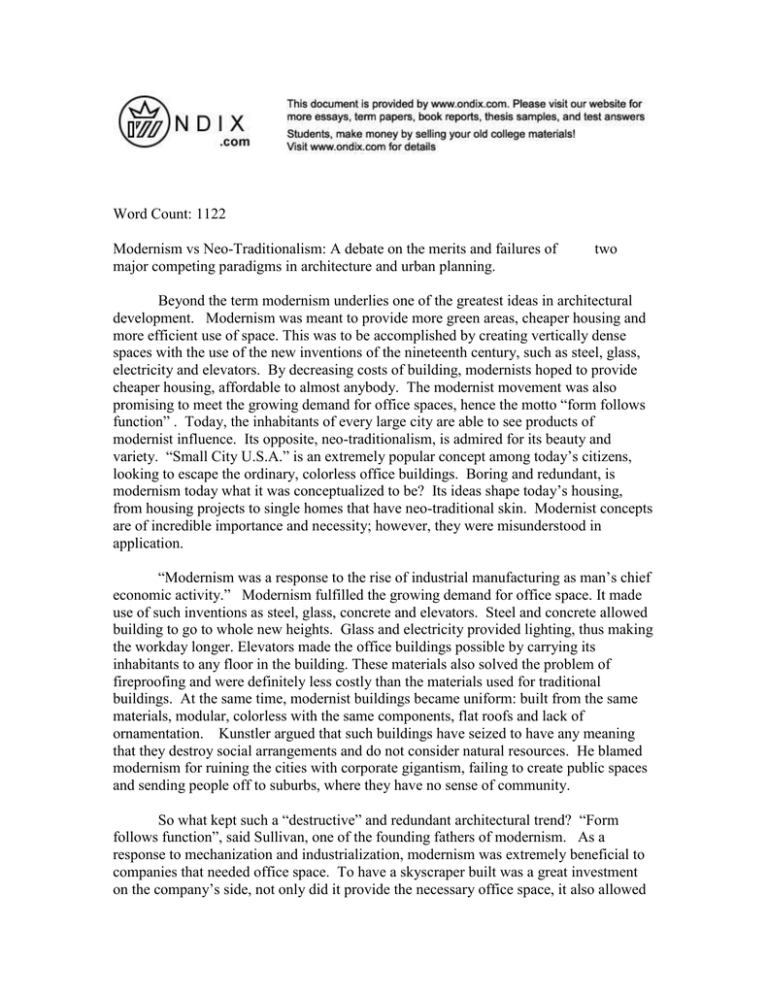
Word Count: 1122 Modernism vs Neo-Traditionalism: A debate on the merits and failures of major competing paradigms in architecture and urban planning. two Beyond the term modernism underlies one of the greatest ideas in architectural development. Modernism was meant to provide more green areas, cheaper housing and more efficient use of space. This was to be accomplished by creating vertically dense spaces with the use of the new inventions of the nineteenth century, such as steel, glass, electricity and elevators. By decreasing costs of building, modernists hoped to provide cheaper housing, affordable to almost anybody. The modernist movement was also promising to meet the growing demand for office spaces, hence the motto “form follows function” . Today, the inhabitants of every large city are able to see products of modernist influence. Its opposite, neo-traditionalism, is admired for its beauty and variety. “Small City U.S.A.” is an extremely popular concept among today’s citizens, looking to escape the ordinary, colorless office buildings. Boring and redundant, is modernism today what it was conceptualized to be? Its ideas shape today’s housing, from housing projects to single homes that have neo-traditional skin. Modernist concepts are of incredible importance and necessity; however, they were misunderstood in application. “Modernism was a response to the rise of industrial manufacturing as man’s chief economic activity.” Modernism fulfilled the growing demand for office space. It made use of such inventions as steel, glass, concrete and elevators. Steel and concrete allowed building to go to whole new heights. Glass and electricity provided lighting, thus making the workday longer. Elevators made the office buildings possible by carrying its inhabitants to any floor in the building. These materials also solved the problem of fireproofing and were definitely less costly than the materials used for traditional buildings. At the same time, modernist buildings became uniform: built from the same materials, modular, colorless with the same components, flat roofs and lack of ornamentation. Kunstler argued that such buildings have seized to have any meaning that they destroy social arrangements and do not consider natural resources. He blamed modernism for ruining the cities with corporate gigantism, failing to create public spaces and sending people off to suburbs, where they have no sense of community. So what kept such a “destructive” and redundant architectural trend? “Form follows function”, said Sullivan, one of the founding fathers of modernism. As a response to mechanization and industrialization, modernism was extremely beneficial to companies that needed office space. To have a skyscraper built was a great investment on the company’s side, not only did it provide the necessary office space, it also allowed to lease the remaining offices to other companies, thus making a profit. Modernism also appealed to the general population since the rise in birth rates provided a greater demand for housing. Many argued that same modular spaces would promote equality among its inhabitants. Modernism also promised to create more public spaces with green areas and waterworks by the virtue of vertical density. Supposedly, there would be more space. Not to forget, the building and maintenance costs of a modernist building were significantly less than that of a traditional one. However, nor Federal Plaza, a textbook modernist landscape, nor housing projects seem to have public spaces around them. Modernism was applied selectively, leaving out perhaps one of its most important functions. And although Mies van der Rohe did say the less is more in terms of ornamentation, there do not seem to be any sources that argue that modernist buildings have to be so redundant. There’s no reason that modernist architecture and can not have some creative expression to make it perhaps a little more appealing to the eye. It is no wonder that so many people like the Harold Washington Library building more than the Federal Plaza, just like it is no wonder that so many people try to escape the modernist landscape by moving farther and farther from the industrial core. As a response to the growing need for beauty, post-modernism and neotraditionalism develop. Neo-traditionalism came out of the longing for the single housing and green spaces, “Small City U.S.A.”. One of the strongest examples of neotraditionalism is the Disney’s creation Celebration, Florida. This planned community has a variety of buildings, around twenty types, that people can buy. All of these buildings have modernist guts and traditional skin. The city appeals by its vast presence of public spaces and the beauty of its housing accommodations. Even the office buildings inside the city are built in the traditional style. This kind of town is what many Americans yearn for after the modernist experience. Neo-traditionalism, of course, has its flaws. The Celebration houses are meant for the elite, with the prices starting at about $ 200,000. Having only traditional housing in every single city would lead to more homeless people who can not afford such housing. However, homes with neo-traditional skin can also be mass-produced. Then, even the traditional homes are touched by modernism. In today’s society, it would be almost impossible to have a completely traditional home. Modernist thinkers had great ideas that were unfortunately diminished to the modernist buildings one sees today. There’s no question that our society needs office buildings and green spaces. Modernism was supposed to provide for both. People who despise modernism, probably do not know what it is supposed to be. Post-modernism seems to be more or less of an answer. It finally lets modernist buildings nurture creativity. Post-modernist buildings vary in shape, size and color, thus making them more appealing to the eye and less redundant. It seems that the costs of such innovations would still be less than those of traditional buildings. I believe that our society needs post-modernism. People long for trees and parks and waterfronts, as well as for buildings that one can look at and think, “Oh, G-d, that is beautiful.” We need this no less than we need office buildings. Modernism and postmodernism are deemed to be different, and they are in the sense that post-modernism is exactly what modernism was supposed to be, may be with a bit more variety. In many instances, post-modernist buildings are even more attractive than neo-traditional. So, maybe one day when all modernist ideals are realized, a person will come out of the new Federal Plaza and for a hundredth time think, “This is the most relaxing landscape I’ve ever seen. Keywords: word count modernism traditionalism debate merits failures major competing paradigms architecture urban planning beyond term modernism underlies greatest ideas architectural development modernism meant provide more green areas cheaper housing more efficient space this accomplished creating vertically dense spaces with inventions nineteenth century such steel glass electricity elevators decreasing costs building modernists hoped provide cheaper housing affordable almost anybody modernist movement also promising meet growing demand office spaces hence motto form follows function today inhabitants every large city able products modernist influence opposite traditionalism admired beauty variety small city extremely popular concept among today citizens looking escape ordinary colorless office buildings boring redundant today what conceptualized ideas shape housing from projects single homes that have traditional skin modernist concepts incredible importance necessity however they were misunderstood application response rise industrial manufacturing chief economic activity fulfilled growing demand office space made such inventions steel glass concrete elevators steel concrete allowed building whole heights glass electricity provided lighting thus making workday longer elevators made buildings possible carrying inhabitants floor building these materials also solved problem fireproofing were definitely less costly than materials used traditional buildings same time became uniform built from same materials modular colorless with same components flat roofs lack ornamentation kunstler argued that such have seized have meaning that they destroy social arrangements consider natural resources blamed ruining cities with corporate gigantism failing create public spaces sending people suburbs where they sense community what kept destructive redundant architectural trend form follows function said sullivan founding fathers response mechanization industrialization extremely beneficial companies needed space skyscraper built great investment company side only provide necessary also allowed lease remaining offices other companies thus making profit appealed general population since rise birth rates provided greater demand many argued modular would promote equality among inhabitants promised create more public green areas waterworks virtue vertical density supposedly there would forget maintenance costs were significantly less than traditional however federal plaza textbook landscape projects seem public around them applied selectively leaving perhaps most important functions although mies rohe less terms ornamentation there seem sources argue redundant there reason architecture some creative expression make perhaps little appealing wonder many people like harold washington library than federal plaza just like wonder many people escape landscape moving farther farther from industrial core response growing need beauty post traditionalism develop came longing single green small city strongest examples disney creation celebration florida this planned community variety around twenty types these guts skin appeals vast presence beauty accommodations even inside built style this kind town what americans yearn after experience course flaws celebration houses meant elite prices starting about having only every single would lead homeless afford however homes skin mass produced then even homes touched society almost impossible completely home thinkers great ideas unfortunately diminished sees question society needs supposed both despise probably know supposed post seems answer finally lets nurture creativity post vary shape size color thus making them appealing seems costs innovations still those believe society needs long trees parks waterfronts well look think beautiful need need deemed different sense exactly supposed variety instances even attractive maybe when ideals realized person will come federal plaza hundredth time think most relaxing landscape ever seen Keywords General: Essay, essays, termpaper, term paper, termpapers, term papers, book reports, study, college, thesis, dessertation, test answers, free research, book research, study help, download essay, download term papers
